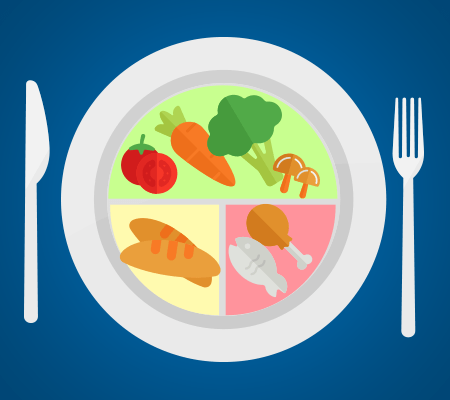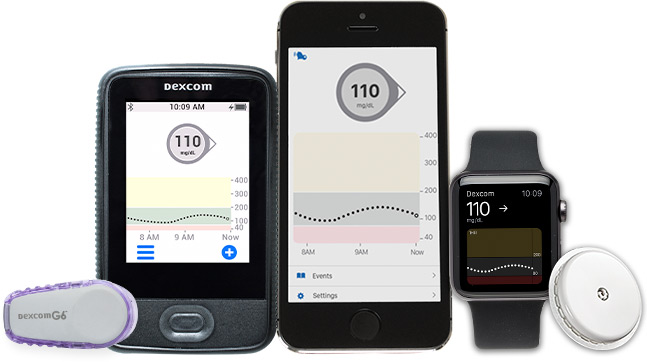Answers to Questions About Diabetes and Food
For a person living with diabetes, making smart food choices is a big part of staying healthy.
This post was reviewed by our Director of Clinical Excellence and Oversight.
How often can I have ice cream? Is meat good or bad? Do I have to count carbs?
If you have been diagnosed with diabetes, you’re sure to have questions about the best food choices you can make to keep your diabetes in check. Food is one of three ways people with diabetes manage their blood sugar. The others are exercise and medication. Keeping everything in balance is the key. If you have diabetes and love to eat, don’t worry—your days of enjoying food are far from over. There are lots of yummy choices that won’t cause your blood sugar to spike!

Diabetes Basics
There are two types of diabetes. Both are considered chronic (ongoing) conditions. If you are among the 1.25 million people living with type 1 diabetes in the U.S., your body does not produce insulin, the hormone that keeps blood sugar in check. An additional 29 million people have been diagnosed with type 2 diabetes. These people make insulin, but it may not be enough or the insulin they do make doesn’t work well enough, also known as insulin resistance.

The types of diabetes are different in important ways. Type 1 typically affects people at a younger age. Also, those with type 1 diabetes must frequently monitor their blood sugar to know how much insulin to take. People with type 2 diabetes may also have to monitor their blood sugar level but they may or may not take insulin. Often, they can use a combination of food, exercise, and medication to improve their body’s use of insulin. Some even do it with diet alone.
When it comes to lifestyle, anyone with diabetes should get regular exercise, quit smoking, and manage their blood pressure and cholesterol. They should also follow a healthy diet with the focus on monitoring their carbohydrate intake.
What’s the Deal with Carbohydrates?
Controlling your carbohydrate (carb) intake plays a major role in managing diabetes. Carbs are important for health because they supply needed energy, but they also raise the level of glucose, or sugar, in the blood. The body breaks carbs into glucose, and the pancreas releases insulin that helps absorb the glucose. Without enough insulin to process the extra glucose, it remains in the blood, which raises your blood sugar level. Not enough glucose can cause low blood sugar, which can happen if the balance of food, medication, and exercise is off.

The three main types of carbs are starches, sugar, and fiber. The carbs with the lowest impact on blood sugar—the ones you want to eat the most of—are nutrient dense, meaning they contain fiber, vitamins, and minerals. Examples are broccoli, tomatoes, and green beans. When choosing starches, opt for brown rice or whole grain bread, rather than simple carbs like cookies and soft drinks that contain lots of white flour and sugar.
Divide (Your Plate) and Conquer!
Experts at the American Diabetes Association have come up with an easy way to use food to help manage your blood sugar. The Diabetes Plate Method shows you how to make wise food choices without weighing, counting, or measuring your food.
Start with a plate that is about nine inches across. Draw an imaginary line down the center, leaving two equal sections, one on the right and one on the left. Now divide the area on the right in two by “drawing” a horizontal line across the middle. This leaves you with one large section and two smaller ones.
To create a healthy meal, fill the large section (half the plate) with non-starchy vegetables like asparagus, broccoli, cauliflower, carrots, cucumber, green beans, mushrooms, peppers, salad greens, and tomatoes. These are low in carbs, so they don’t raise your blood sugar. They’re also high in vitamins, minerals, and fiber.

Fill one of the small sections (a quarter of your plate) with sources of lean protein like fish, chicken, turkey, eggs, lean beef, lean pork, or cottage cheese. You may prefer plant-based proteins such as beans, lentils, tofu, nuts, and meat substitutes. The other small section of your plate is for carbohydrates such as grains (bread, rice, pasta), starchy vegetables (like potatoes and green peas), as well as fruit, milk, and other dairy products. Complete your meal with a low- or no-calorie beverage like unsweetened coffee and tea, or sparkling water.
When you come across a food that doesn’t fit easily into the Diabetic Plate Method because it is made of several ingredients, make choices about such combination foods by looking at what’s in them and “placing” the ingredients in the proper section of the plate. When thinking about pizza, for example, the crust is a carb, the cheese and meat on top are protein, and your mushrooms and peppers are non-starchy vegetables. To make that slice of pizza a better choice for your diabetic meal plan, ask for thin crust and light cheese, and opt for veggies instead of fatty sausage.
Delicious Dishes for People with Diabetes, and Everyone Else!
Once you start to think in terms of fewer carbs and more vegetables and lean protein, it’s incredible how creative you can get with your food choices. Be sure to speak with your healthcare providers about how and what to eat to ensure your blood glucose levels stay within the range your doctor says is right for you.
Diabetes Food Hub is a great resource for diabetes-friendly recipes the whole family will love. You’ll even find ideas for delicious desserts, like berry crisp and chocolate brownies! Below are a few idea starters for breakfast, lunch, and dinner:
Breakfast
- Spinach and mushroom egg scramble
- Oatmeal pecan pancakes
- Egg and avocado toast
Lunch
- Whole wheat hot pockets
- Chicken Caesar salad wrap
- Low-carb lunch box with turkey, cheese, and avocado
Dinner
- Air fryer coconut shrimp
- Meatballs and spaghetti squash
- Steak and portobello mushroom sandwich
Good Habits for Good Health
For a person living with diabetes, making smart food choices is a big part of staying healthy, along with taking the right medications and getting regular exercise. When visiting your healthcare professionals, be sure to ask about the latest diabetic supplies and devices, like Continuous Glucose Monitors (CGMs) that make it easier than ever to live well with diabetes!
Let HCD Be Your Medical Supply Partner
HCD has a wide range of diabetes supplies, including Blood Glucose Monitors, Continuous Glucose Monitors, insulin pumps and insulin delivery devices, personal diabetes management tools, and lancets, test strips, and syringes. Our experts will coordinate with your healthcare professionals to help you get the products you need shipped right to your door. Our knowledgeable customer care representatives can answer your questions about insurance coverage and we even handle all the paperwork. We are eager to help. Let us give you a call by entering your phone number on the bottom left of the screen.

Get Insurance-Covered CGM & Diabetes Supplies
Monthly Deliveries | We Handle the Paperwork

Disclaimer:
Unless otherwise noted, the recommendations in this document were obtained from the sources indicated. Be advised that information contained herein is intended to serve as a useful reference for informational purposes only. HCD cannot be held responsible for the continued accuracy of or for any errors or omissions in the information. All trademarks and registered trademarks are the property of their respective owners.

